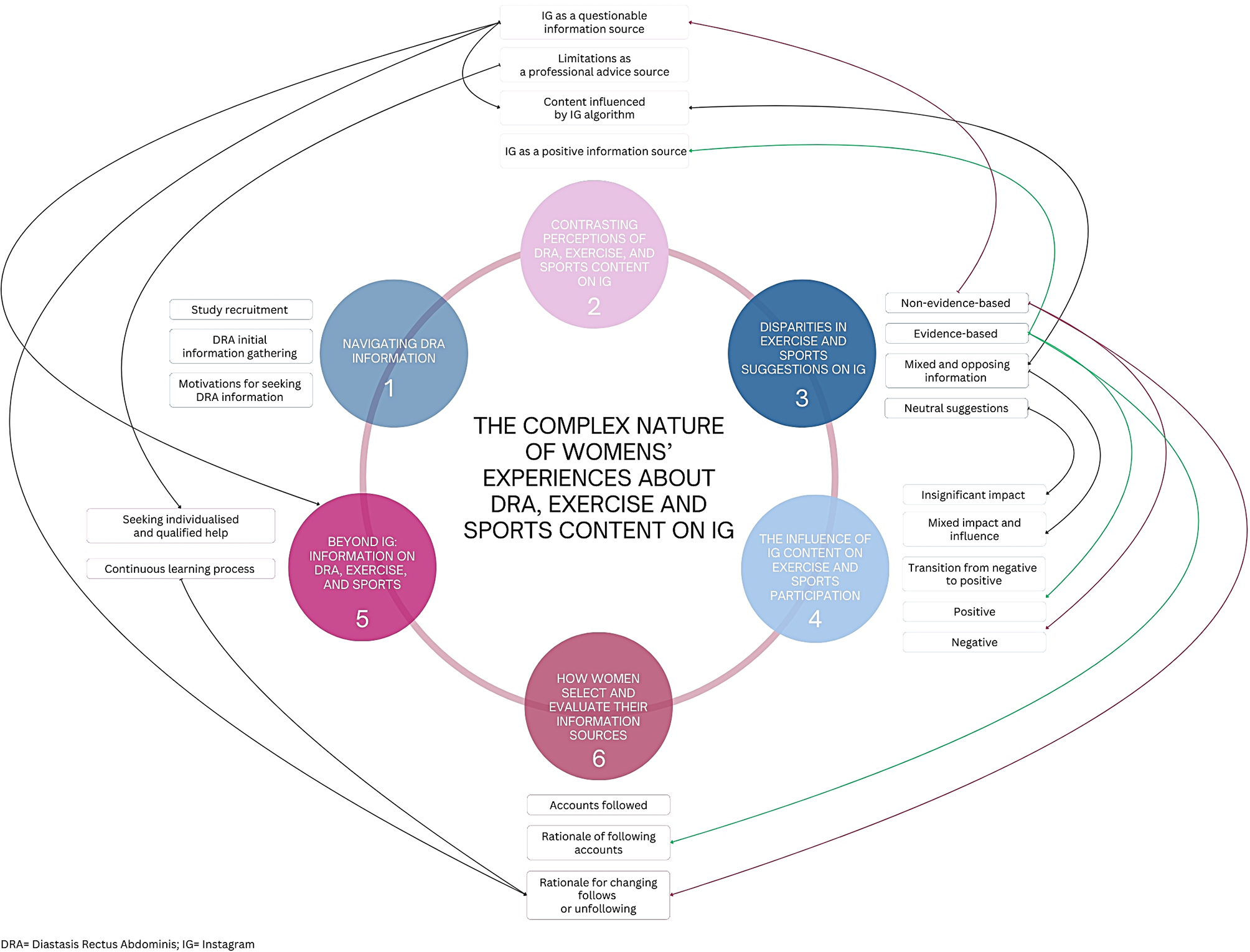Boissonnault JS, Blaschak MJ. Incidence of diastasis recti abdominis during the childbearing year. Phys Ther. 1988;68(7):1082–6.
Article
CAS
PubMed
Google Scholar
Mota P, Pascoal AG, Bo K. Diastasis recti abdominis in pregnancy and postpartum period. Risk factors, functional implications and resolution. Curr Womens Health Rev. 2015;11(1):59–67.
Article
Google Scholar
Cardaillac C, Vieillefosse S, Oppenheimer A, Joueidi Y, Thubert T, Deffieux X. Diastasis of the rectus abdominis muscles in postpartum: concordance of patient and clinician evaluations, prevalence, associated pelvic floor symptoms and quality of life. Eur J Obstet Gynecol Reprod Biol. 2020;252:228–32.
Article
PubMed
Google Scholar
Sperstad JB, Tennfjord MK, Hilde G, Ellström-Engh M, Bø K. Diastasis recti abdominis during pregnancy and 12 months after childbirth: prevalence, risk factors and report of lumbopelvic pain. Br J Sports Med. 2016;50(17):1092–6.
Article
PubMed
Google Scholar
Fuentes Aparicio L, Rejano-Campo M, Donnelly GM, Vicente-Campos V. Self-reported symptoms in women with diastasis rectus abdominis: A systematic review. J Gynecol Obstet Hum Reprod. 2021;50(7).
Eriksson Crommert M, Petrov Fieril K, Gustavsson C. Women’s experiences of living with increased inter-recti distance after childbirth: an interview study. BMC Womens Health. 2020;20(1):260.
Article
PubMed
PubMed Central
Google Scholar
Gluppe S, Ellström Engh M, Bø K. Primiparous women’s knowledge of diastasis recti abdominis, concerns about abdominal appearance, treatments, and perceived abdominal muscle strength 6–8 months postpartum. A cross sectional comparison study. BMC Womens Health. 2022;22(1):428.
Article
PubMed
PubMed Central
Google Scholar
Weingerl I, Kozinc Ž, Šarabon N. The effects of Conservative interventions for treating diastasis recti abdominis in postpartum women: a review with Meta-analysis. SN Compr Clin Med. 2022;5(1):10.
Article
PubMed
PubMed Central
Google Scholar
Marander V, Råheim M, Haukenes I, Theodorsen NM. Mothers’ experiences living with diastasis recti abdominis– an interview study. BMC Womens Health. 2024;24(1):292.
Article
PubMed
PubMed Central
Google Scholar
Lentzen MP, Trojtza S, Zinser M, Kreppel M, Zoeller JE, Zirk M, #facialtraumasurgery. Educational content of Instagram as a social media source for facial trauma surgery. J Craniofac Surg. 2021;32(8):2794–7.
Article
PubMed
Google Scholar
Larsen MK, Thygesen TH. Orthognathic surgery: outcome in a Facebook group. J Craniofac Surg. 2016;27(2):350–5.
Article
PubMed
Google Scholar
Wang Y, McKee M, Torbica A, Stuckler D. Systematic literature review on the spread of Health-related misinformation on social media. Soc Sci Med. 2019;240:112552.
Article
PubMed
PubMed Central
Google Scholar
Pace LA, Herbert AS, Malik RD. Characteristics of pelvic organ prolapse content available on social media. Neurourol Urodyn. 2021;40(5):1165–74.
Article
PubMed
Google Scholar
Minaglia S, Kaneshiro B, Soules K, Harvey S, Grzankowski K, Millet L, et al. Assessment of internet-based information regarding pelvic organ prolapse and urinary incontinence. Female Pelvic Med Reconstr Surg. 2012;18(1):50–4.
Article
PubMed
Google Scholar
Dueñas-Garcia OF, Kandadai P, Flynn MK, Patterson D, Saini J, O’Dell K. Patient-focused websites related to stress urinary incontinence and pelvic organ prolapse: a DISCERN quality analysis. Int Urogynecol J. 2015;26(6):875–80.
Article
PubMed
Google Scholar
Brito LGO. Is social media really impacting urogynecology? Int Urogynecol J. 2021;32(2):237–8.
Article
PubMed
Google Scholar
Mazloomdoost D, Kanter G, Chan RC, Deveaneau N, Wyman AM, Von Bargen EC et al. Social networking and Internet use among pelvic floor patients: a multicenter survey. Am J Obstet Gynecol. 2016;215(5):654.e1-654.e10.
Sajadi KP, Goldman HB, Firoozi F. Assessing internet health information on female pelvic floor disorders. J Urol. 2011;186(2):594–6.
Article
PubMed
Google Scholar
Sajadi KP, Goldman HB. Social networks lack useful content for incontinence. Urology. 2011;78(4):764–7.
Article
PubMed
Google Scholar
Dowding D. Best Practices for Mixed Methods Research in the Health Sciences John, Creswell W, Klassen AC. Vicki L. Plano Clark, Katherine Clegg Smith for the Office of Behavioral and Social Sciences Research; Qualitative Methods Overview Jo Moriarty. Qualitative Social Work. 2013;12(4):541–5.
Creswell JW. Qualitative, quantitative, and mixed methods approaches. Research Design Qualitative Quantitative and Mixed Methods Approaches. 4th Edition. Research Design. SAGE Publications Inc.; 2013.
Creswell JW, Plano Clark VL. Designing and Conducting Mixed Methods Research. 2nd Edition. SAGE Publications Inc.; 2011.
O’Cathain A, Murphy E, Nicholl J. The quality of mixed methods studies in health services research. J Health Serv Res Policy. 2008;13(2):92–8.
Article
PubMed
Google Scholar
Giagio S, Rial Rebullido T, Salvioli S, Innocenti T, Pillastrini P, Moore IS et al. Analysis and perception of Instagram posts referring to diastasis recti abdominis, exercise and sports-related content: a mixed-method study protocol. medRxiv [Internet]. 2023;2023.07.05.23292242.
Benjamin DR, van de Water ATM, Peiris CL. Effects of exercise on diastasis of the rectus abdominis muscle in the antenatal and postnatal periods: a systematic review. Physiotherapy. 2014;100(1):1–8.
Article
CAS
PubMed
Google Scholar
Benjamin DR, Frawley HC, Shields N, Peiris CL, van de Water ATM, Bruder AM, et al. Conservative interventions May have little effect on reducing diastasis of the rectus abdominis in postnatal women– A systematic review and meta-analysis. Physiotherapy. 2023;119:54–71.
Article
PubMed
Google Scholar
Berg-Poppe P, Hauer M, Jones C, Munger M, Wethor C. Use of exercise in the management of postpartum diastasis recti: A systematic review. J Womens Health Phys Th. 2022;46(1):35–47.
Article
Google Scholar
Gluppe SB, Ellström M, Bø K. Curl-up exercises improve abdominal muscle strength without worsening inter-recti distance in women with diastasis recti abdominis postpartum: a randomised controlled trial. J Physiother. 2023;69(3):160–7.
Article
PubMed
Google Scholar
Dufour S, Petrusevski C. Does research support the current Conservative care recommendations for pregnancy-related diastasis rectus abdominis? A scoping review. J Pelvic Obstetric Gynaecol Physiotherapy. 2024;134:13–30.
Article
Google Scholar
Skoura A, Billis E, Papanikolaou DT, Xergia S, Tsarbou C, Tsekoura M, et al. Diastasis recti abdominis rehabilitation in the postpartum period: A scoping review of current clinical practice. Int Urogynecol J. 2024;35(3):491–520.
Article
PubMed
PubMed Central
Google Scholar
Kimber Ml, Meyer S, Mchugh Tl, Thornton J, Khurana R, Sivak A et al. Health outcomes after pregnancy in elite athletes: A systematic review and Meta-analysis. Med Sci Sports Exerc. 2021;53(8).
Vesting S, Gutke A, Fagevik Olsén M, Rembeck G, Larsson MEH. The impact of exercising on pelvic symptom severity, pelvic floor muscle strength, and diastasis recti abdominis after pregnancy: A longitudinal prospective cohort study. Phys Ther. 2024;104(4):1.
Article
Google Scholar
Theodorsen NM, Fersum KV, Moe-Nilssen R, Bo K, Haukenes I. Effect of a specific exercise programme during pregnancy on diastasis recti abdominis: study protocol for a randomised controlled trial. BMJ Open. 2022;12(2):e056558.
Article
PubMed
PubMed Central
Google Scholar
Mottola MF, Davenport MH, Ruchat SM, Davies GA, Poitras VJ, Gray CE, et al. 2019 Canadian guideline for physical activity throughout pregnancy. Br J Sports Med. 2018;52(21):1339.
Article
PubMed
Google Scholar
Lee N, Bae YH, Fong SSM, Lee WH. Effects of pilates on inter-recti distance, thickness of rectus abdominis, waist circumference and abdominal muscle endurance in primiparous women. BMC Womens Health. 2023;23(1):626.
Article
PubMed
PubMed Central
Google Scholar
Toprak Celenay S, Balaban M, Ozer Kaya D. Immediate effects of corrective exercise versus curl-up in women with diastasis recti abdominis. J Bodyw Mov Ther. 2024;40:1610–4.
Article
PubMed
Google Scholar
Deering RE, Chumanov ES, Stiffler-Joachim MR, et al. Exercise program reduces inter-Recti distance in female runners up to two years postpartum. J Womens Health Phys Th. 2020;44:9–18.
Article
Google Scholar
Gluppe S, Engh ME, Bø K. What is the evidence for abdominal and pelvic floor muscle training to treat diastasis recti abdominis postpartum? A systematic review with meta-analysis. Braz J Phys Ther. 2021 Nov-Dec;25(6):664–75.
Robillard JM, Jun JH, Lai JA, Feng TL. The QUEST for quality online health information: validation of a short quantitative tool. BMC Med Inf Decis Mak. 2018;18(1):87.
Article
Google Scholar
Palinkas LA, Horwitz SM, Green CA, Wisdom JP, Duan N, Hoagwood K. Purposeful sampling for qualitative data collection and analysis in mixed method implementation research. Adm Policy Ment Health. 2015;42(5):533–44.
Article
PubMed
PubMed Central
Google Scholar
Montserrat Rejano-Campo. The Diastasis Rectus Abdominis Questionnaire: development and initial validation of a questionnaire for the evaluation of the symptoms and consequences of diastasis rectus abdominis [Internet]. Mendeley. 2022. Available from: https://data.mendeley.com/datasets/wtj4v5g24n/1
Saunders B, Sim J, Kingstone T, Baker S, Waterfield J, Bartlam B, et al. Saturation in qualitative research: exploring its conceptualization and operationalization. Qual Quant. 2018;52(4):1893–907.
Article
PubMed
Google Scholar
Malterud K. Qualitative research: standards, challenges, and guidelines. Lancet. 2001;358(9280):483–8.
Article
CAS
PubMed
Google Scholar
Braun V, Clarke V. Thematic analysis. APA handbook of research methods in psychology, vol 2: research designs: quantitative, qualitative, neuropsychological, and biological. Washington, DC, US: American Psychological Association; 2012. pp. 57–71.
Chapter
Google Scholar
Bradley EH, Curry LA, Devers KJ. Qualitative data analysis for health services research: developing taxonomy, themes, and theory. Health Serv Res. 2007;42(4):1758–72.
Article
PubMed
PubMed Central
Google Scholar
Braun V, Clarke V. Using thematic analysis in psychology. Qual Res Psychol. 2006;3(2):77–101.
Article
Google Scholar
Norman K, Denzin YSL. The SAGE handbook of qualitative research. Fourth edition. Thousand Oaks: SAGE, [2011] ©2011.
Dufour S, Hondronicols A, Flanigan K. Enhancing pelvic health: optimizing the services provided by primary health care teams in Ontario by integrating physiotherapists. Physiother Can. 2019;71(2):168–75.
Article
PubMed
PubMed Central
Google Scholar
Keeler J, Albrecht M, Eberhardt L, Horn L, Donnelly C, Lowe D. Diastasis recti abdominis: A survey of women’s health specialists for current physical therapy clinical practice for postpartum women. J Womens Health Phys Th. 2012;36(3).
Hayman M, Keppel M, Stanton R, Thwaite TL, Alfrey KL, Alley S, et al. A mixed-methods exploration of attitudes towards pregnant Facebook fitness influencers. BMC Public Health. 2023;23(1):569.
Article
PubMed
PubMed Central
Google Scholar
Stewart M, Loftus S. Sticks and stones: the impact of Language in musculoskeletal rehabilitation. J Orthop Sports Phys Ther. 2018;48(7):519–22.
Article
PubMed
Google Scholar
Putukian M, Blauwet C, Currie A, Gouttebarge V, McDuff D, Mountjoy ML, et al. Social media impact on athlete mental health: #realitycheck. Br J Sports Med. 2024 Feb;19:bjsports–2023.
Alam R, Biles MJ, Patel HD, Pavlovich CP, Schwen ZR. Longitudinal analysis of YouTube videos discussing post-prostatectomy erectile dysfunction. Urol Oncol. 2023;41(4):e20511–6.
Article
Google Scholar
Curtis RG, Prichard I, Gosse G, Stankevicius A, Maher CA. Hashtag fitspiration: credibility screening and content analysis of Instagram fitness accounts. BMC Public Health. 2023;23(1):1–7.
Article
Google Scholar
Maia LB, Silva JP, Souza MB, Henschke N, Oliveira VC. Popular videos related to low back pain on youtube™ do not reflect current clinical guidelines: a cross-sectional study. Braz J Phys Ther. 2021;25(6):803–10.
Article
PubMed
PubMed Central
Google Scholar
Marocolo M, Meireles A, de Souza HLR, Mota GR, Oranchuk DJ, Arriel RA et al. Is social media spreading misinformation on exercise and health in brazil?? Int J Environ Res Public Health. 2021;18(22).
Chou WYS, Oh A, Klein WMP. Addressing Health-Related misinformation on social media. JAMA. 2018;320(23):2417–8.
Article
PubMed
Google Scholar
Bhatia A, Gaur PS, Zimba O, Chatterjee T, Nikiphorou E, Gupta L. The untapped potential of Instagram to facilitate rheumatology academia. Clin Rheumatol. 2022;41(3):861–7.
Article
PubMed
Google Scholar










